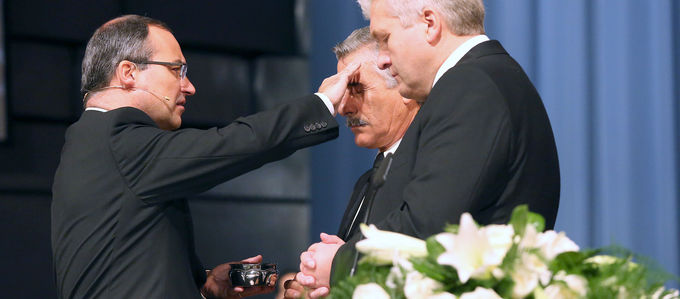
It happened in 1840/41: the apostle unity fell apart and so did the masterplan. The charismatic movement had to reinvent itself as a church. Here is the background to sealing in the Catholic Apostolic Church.
The whole thing was triggered by the conflict with the Council of Zion, the council of the seven London churches. Inspired by prophecies around 1838, influential ministers viewed their council as a kind of church parliament and the Apostles as church officers that had to implement the decisions made by it. The Apostles, on the other hand, saw themselves as leaders of the Church and the Council as an advisory body.
The Apostles were not entirely blameless for the situation: after their calling, they holed themselves up in Albury for a period of retreat and then swarmed out to explore the countries assigned to them, leaving the founding churches to their own devices for years.
Then the Apostles filled the power vacuum. They returned home, disbanded the Council, forbade ministers to act on prophetic words, and set out terms under which they were prepared to continue their service. For the first time, the Apostles acted independently and without first waiting for prophetic impulses. This achievement was to cost them dearly.
Ministry nearly without mandate
The circle of Apostles lost a member, its capacity to act, and its long-term perspective: Duncan MacKenzie did not consider the college entitled to take such decisions just yet—at least not at this stage of God’s prophetically announced plan for the Church. MacKenzie no longer saw himself able to exercise his ministry and resigned.
This made the prophetic commandment to always act unanimously practically impossible to fulfil. And the last phase after the calling and separation of the Apostles, namely their being sent forth—in a new, widespread authority of the Holy Spirit—receded into the unknown distance.
The Apostles handled this situation very differently: Henry Drummond no longer considered the Church as such feasible and relied on congregational life. Thomas Carlyle still trusted that the Apostles would be sent out and pleaded for action to complete the number of Apostles to twelve again. John Bate Cardale, the pillar of the College of Apostles, intensified his efforts to establish the church.
The Spirit revived
Cardale, a lawyer, produced a comprehensive liturgy. The new forms of worship, including vestments, were first used in 1842. However, this idea met with little approval, and sometimes even with dissent—even among the Apostles. One accusation was: as vestments bind the body, so liturgy binds the Spirit.
Soon the rectors complained to the Apostles that there was a feeling of deadness, of want of a conscious spiritual life among the members of their churches. Because of the difficulties and disappointments, the number of members had dwindled.
In this situation, the Apostles felt that the time had come to introduce sealing. Already in 1835, Edward Oliver Taplin, the so-called Pillar of Prophets, had described the administering of the Spirit as a task of the Apostles. Already The Great Testimony of 1837 mentioned the laying on of hands. Then, in 1847, things moved very fast.
From the inside out
The sealing campaign that started on 31 May 1847 followed a certain pattern: first Cardale’s three closest co-workers were sealed, Prophets, Evangelists, and Shepherds; then the rectors (referred to as angels) of the seven London congregations; and finally the congregation of the central church in London. The sealings began to be administered in London, spread to England and Scotland, and then to Canada (September 1847) and Germany (17 October 1847).
The laying on of hands had a salutary effect. The apathy that had developed in the congregations gave way to new life. By this time at the latest the charismatic movement with its spontaneous and often unpredictable flashes of inspiration had become a well-ordered Church.
The hands of the Apostles acted as channels for the Holy Spirit. This became even more evident in the Catholic Apostolic Church’s theological understanding of sealing. This will be the subject of the next part.
A comprehensive overview of the history of the Catholic Apostolic Church can be found in the brochure “The Making of the New Apostolic Church” by Dr Manfred Henke, which can be downloaded from nak.org.
Photo: Vector Tradition – stock.adobe.com














